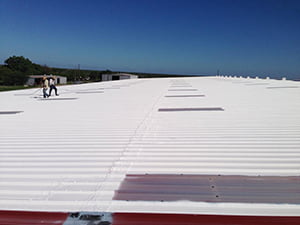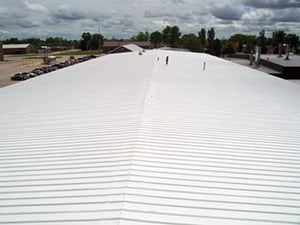
Commercial building owners seeking to reduce energy costs and improve sustainability are increasingly turning to roof restoration as a cost-effective solution. Professional roof restoration can significantly improve a building’s energy efficiency while extending the roof’s lifespan and reducing operating expenses.
To schedule a consultation for your Bismarck, ND commercial building, call 701-202-7280 to speak with the experts at Eagle Eye Roofing Systems.
The Impact of Roof Condition on Energy Consumption
A deteriorating commercial roof can lead to substantial energy waste through poor insulation and heat transfer. Studies show that buildings with compromised roofing systems can lose up to 30% of their air conditioning through the roof structure. This heat loss translates directly into higher heating and cooling costs, putting unnecessary strain on HVAC systems.
Key Energy-Saving Benefits of Roof Restoration
Roof restoration offers multiple pathways to enhance energy efficiency. Modern roof coating systems can reflect up to 85% of solar radiation, dramatically reducing heat absorption. This reflective capability helps maintain consistent indoor temperatures and reduces the cooling load during summer months.
Additionally, professional restoration addresses issues like air leaks and deteriorated insulation. Sealing these vulnerable areas prevents conditioned air from escaping and stops outside air from infiltrating the building envelope. The result is more stable indoor temperatures and reduced HVAC system workload.
Cost-Effective Energy Management Solution
Energy savings from a restored roof often deliver ROI within 3-5 years through reduced utility bills and HVAC maintenance costs. Many buildings report 15-25% reductions in cooling expenses after professional roof restoration.

Environmental Benefits and Sustainability
Beyond immediate energy savings, roof restoration supports broader sustainability goals. By extending the existing roof’s lifespan, restoration reduces construction waste and conserves materials. Modern coating systems are often eco-friendly and can help buildings qualify for LEED certification points.
Long-Term Performance Improvements
A properly restored roof can extend service life by 10-15 years while maintaining its energy-efficient properties. Regular maintenance and periodic recoating help sustain these benefits, providing lasting value for commercial property owners.
Professional Assessment and Implementation
Building owners should partner with qualified contractors who can evaluate current roof conditions and recommend appropriate restoration solutions. Energy audit data can help identify problem areas and quantify potential savings from restoration work.
Local Roof Restoration Experts
Roof restoration represents a smart investment for commercial building owners looking to improve energy efficiency and reduce operating costs. The combination of immediate energy savings, extended roof life, and environmental benefits makes restoration an attractive alternative to full replacement. Property owners who prioritize this improvement often see significant returns through reduced energy consumption and improved building performance.
To learn more about the impact roof coatings offers the bottom line for your Bismarck, ND commercial building, call our experts at 701-202-7280 and schedule a consultation.
Commercial Roof Restoration FAQs
Q: How much can roof restoration reduce energy costs?
Commercial buildings typically see 15-25% reductions in cooling costs after professional roof restoration. Energy savings vary based on building size, climate, and existing roof condition.
Q: What’s the lifespan of a restored commercial roof?
A professionally restored roof can last 10-15 years with proper maintenance. Regular inspections and recoating help maintain energy-efficient properties throughout this period.
Q: Is roof restoration more cost-effective than replacement?
Yes. Restoration typically costs significantly less than full replacement while providing substantial energy efficiency benefits and extended roof life.
Q: What types of commercial buildings benefit most from roof restoration?
Large commercial structures with flat or low-slope roofs, including warehouses, retail centers, and office buildings, typically see the greatest energy efficiency improvements after restoration.
Q: How do I know if my commercial roof is suitable for restoration?
Professional contractors can assess your roof’s condition through moisture scanning, core sampling, and visual inspection to determine if restoration is viable. Generally, roofs with less than 25% moisture damage are good candidates.
Q: What maintenance is required after roof restoration?
Annual inspections, cleaning of drainage systems, and addressing minor repairs promptly help maintain energy efficiency benefits. Recoating may be needed every 5-7 years depending on environmental conditions.
